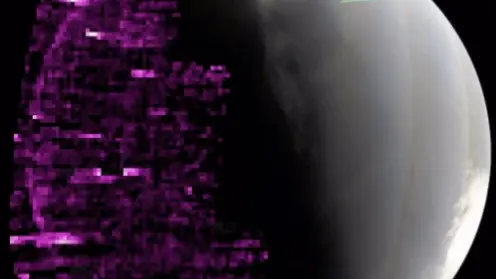Updated 19 June 2024 at 23:18 IST
"Purple Rain": NASA's MAVEN Captures Mesmerizing Martian Auroras Caused by Solar Storm
NASA's MAVEN orbiter captures stunning purple auroras on Mars' nightside, showing different aurora patterns due to Mars' lack of magnetic field.
- Science News
- 2 min read

NASA has once again amazed space enthusiasts with a mesmerizing glimpse of the universe. This time, the space agency delighted its Instagram followers with an animated GIF showcasing auroras on Mars' nightside.
Captured by NASA's Imaging Ultraviolet Spectrograph instrument aboard the MAVEN (Mars Atmosphere and Volatile EvolutioN) orbiter, this rare phenomenon is a visual treat.
In its recent post, NASA shared:
"The purple color in this video shows auroras across Mars' nightside as detected by the Imaging Ultraviolet Spectrograph instrument aboard NASA's MAVEN (Mars Atmosphere and Volatile EvolutioN) orbiter. The brighter the purple, the more auroras were present. Taken as waves of energetic particles from a solar storm were arriving at Mars, the sequence pauses at the end, when the wave of the most energetic particles arrived and overwhelmed the instrument with noise," NASA wrote in the caption of the post.
Check out the post:
These stunning purple-colored lights were observed on Mars between May 14 and May 20 this year. NASA explained that auroras on Mars occur differently than on Earth:
Advertisement
"Our home planet is shielded from charged particles by a robust magnetic field, which normally limits auroras to regions near the poles. (Solar maximum is the reason behind the recent auroras seen as far south as Alabama.) Mars lost its internally generated magnetic field in the ancient past, so there's no protection from the barrage of energetic particles. When charged particles hit the Martian atmosphere, it results in auroras that engulf the entire planet," the space agency explained.
User's reactions to the post:
“Wow! That's unbelievably beautiful.”
Advertisement
“Wow, that's amazing.”
“That's incredible! Any plans from NASA to photograph the aurora from the surface? Or will that need to wait for a future human mission?”
“But aurora is mostly in green colour right? It looks completely different.”
This captivating display is a result of waves of energetic particles from a solar storm interacting with Mars' atmosphere. The animated GIF shows the auroras intensifying, with the brightest purples indicating the highest concentration of auroras. The sequence ends dramatically as the most energetic particles arrive, overwhelming the instrument with noise.
Published By : Garvit Parashar
Published On: 19 June 2024 at 23:18 IST
